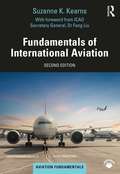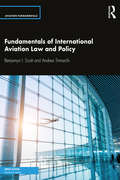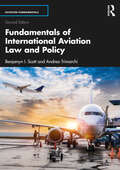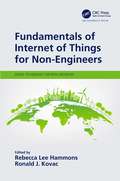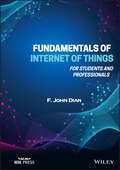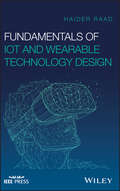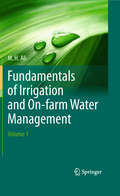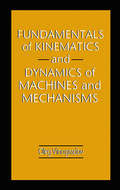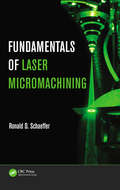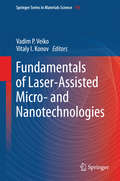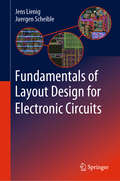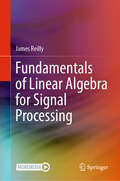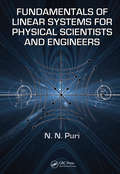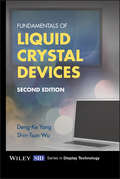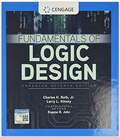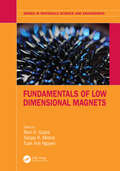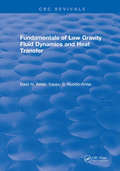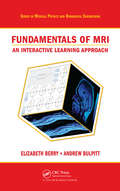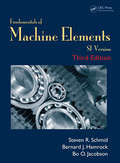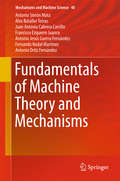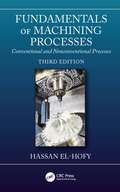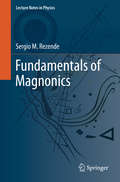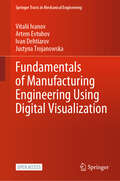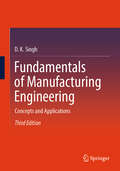- Table View
- List View
Fundamentals of International Aviation (Aviation Fundamentals)
by Suzanne K. KearnsInternational aviation is a massive and complex industry that is crucial to our global economy and way of life. Designed for the next generation of aviation professionals, Fundamentals of International Aviation, second edition, flips the traditional approach to aviation education. Instead of focusing on one career in one country, it introduces readers to the air transport sector on a global scale with a broad view of all the interconnected professional groups. This text provides a foundation of ‘how aviation works’ in preparation for any career in the field (including regulators, maintenance engineers, pilots, flight attendants, airline and airport managers, dispatchers, and air traffic controllers, among many others). Each chapter introduces a different cross-section of the industry, from air law to operations, security to environmental impacts. A variety of learning tools are built into each chapter, including 24 case studies that describe an aviation accident related to each topic. This second edition adds new learning features, geographic representation from Africa, a new chapter on economics, full-color illustrations, and updated and enhanced online resources. This accessible and engaging textbook provides a foundation of industry awareness that will support a range of aviation careers. It also offers current air transport professionals an enriched understanding of the practices and challenges that make up the rich fabric of international aviation.
Fundamentals of International Aviation Law and Policy (Aviation Fundamentals)
by Benjamyn I. Scott Andrea TrimarchiFundamentals of International Aviation Law and Policy offers students a systematic, tailored and dynamic approach to understanding the legal scenario concerning international civil aviation. The book dynamically covers the major areas of international aviation law, and provides an introduction to the multifaceted international regulation of aviation activities in the sphere of public and private law. The book is designed to provide the reader with the fundamental notions concerning international aviation law. It adopts an interactive approach, which aims at engaging the reader by way of using learning tools. The main areas of public and private aviation law are dealt with from a regulatory and practical perspective, and include detailed analyses of existing and applicable legislations, as well as landmark court cases and decisions. Each chapter is tailored to confer to readers a thorough knowledge of the international and, if any, the European applicable legislation. Delivery of these aims is attained through a dynamic and balanced use of didactic instruments and immediate information. The book is intended for a varied audience of students and professionals involved in the aviation world, without requiring the possession of specific legal knowledge or background. It also aims to constitute a useful reference material for those who are familiar with legal terminology and aviation specifics.
Fundamentals of International Aviation Law and Policy (ISSN)
by Benjamyn I. Scott Andrea TrimarchiFundamentals of International Aviation Law and Policy offers students a systematic, tailored and dynamic approach to understanding the legal scenario concerning international civil aviation. The book covers the major areas of international aviation law and provides an introduction to the multifaceted international regulation of aviation activities in the sphere of public and private law. The book is designed to provide the reader with the fundamental notions concerning international aviation law. It adopts an interactive approach, which aims at engaging the reader by way of using learning tools. The main areas of public and private aviation law are dealt with from a regulatory and practical perspective, and include detailed analyses of existing and applicable legislations, as well as landmark court cases and decisions.Each chapter is tailored to confer to readers a thorough knowledge of the applicable international and, if any, the European legislation. Delivery of these aims is attained through a clear and balanced use of didactic instruments and immediate information. New chapters cover aircraft financing and advanced air mobility, giving this second edition of Fundamentals of International Aviation Law and Policy even greater coverage and depth.The book is intended for a varied audience of students and professionals involved in the aviation world, without requiring the possession of specific legal knowledge or background. It also constitutes a useful reference material for those who are familiar with legal terminology and aviation specifics.
Fundamentals of Internet of Things for Non-Engineers (Technology for Non-Engineers)
by Ronald J. Kovac Rebecca Lee HammonsThe IoT is the next manifestation of the Internet. The trend started by connecting computers to computers, progressed to connecting people to people, and is now moving to connect everything to everything. The movement started like a race—with a lot of fanfare, excitement, and cheering. We’re now into the work phase, and we have to figure out how to make the dream come true. The IoT will have many faces and involve many fields as it progresses. It will involve technology, design, security, legal policy, business, artificial intelligence, design, Big Data, and forensics; about any field that exists now. This is the reason for this book. There are books in each one of these fields, but the focus was always "an inch wide and a mile deep." There’s a need for a book that will introduce the IoT to non-engineers and allow them to dream of the possibilities and explore the work venues in this area. The book had to be "a mile wide and a few inches deep." The editors met this goal by engaging experts from a number of fields and asking them to come together to create an introductory IoT book. Fundamentals of Internet of Things for Non-Engineers Provides a comprehensive view of the current fundamentals and the anticipated future trends in the realm of Internet of Things from a practitioner’s point of view Brings together a variety of voices with subject matter expertise in these diverse topical areas to provide leaders, students, and lay persons with a fresh worldview of the Internet of Things and the background to succeed in related technology decision-making Enhances the reader’s experience through a review of actual applications of Internet of Things end points and devices to solve business and civic problems along with notes on lessons learned Prepares readers to embrace the Internet of Things era and address complex business, social, operational, educational, and personal systems integration questions and opportunities
Fundamentals of Internet of Things: For Students and Professionals
by F. John DianFUNDAMENTALS OF INTERNET OF THINGS Fundamentals of Internet of Things: For Students and Professionals teaches the principles of IoT systems. It employs a systematic approach to explain IoT architecture models and their layers. The textbook is arranged based on various layers of an architecture model. For readers who are unfamiliar with the concept of data communication and networks, the first chapter of this book covers the fundamentals of data communication and networks. It can also be used as review material for those who are already familiar with the concept. The book begins with many examples of IoT use cases to show readers how IoT can be applied to various IoT verticals. The concept of smart sensors is then described, as well as their applications in the IoT ecosystem. Because internet connectivity is an essential part of any IoT system, the book explores wired and wireless connectivity schemes including cellular IoT in the 4G and 5G eras. IoT protocols, analytics, as well as IoT security and privacy are important topics that are explained in this book with simple explanations. The last chapter of this book is dedicated to IoT solution development. IoT is one of the most rapidly evolving technologies today, and there is no better guide to this rapidly expanding sector than Fundamentals of Internet of Things (IoT) for Students and Professionals. Features: Simple explanations of complex concepts More than 300 exercise problems and advanced exercise questions Provided solutions for the exercise problems 10 practical IoT projects
Fundamentals of IoT and Wearable Technology Design
by Haider RaadExplore this indispensable guide covering the fundamentals of IOT and wearable devices from a leading voice in the field Fundamentals of IoT and Wearable Technology Design delivers a comprehensive exploration of the foundations of the Internet of Things (IoT) and wearable technology. Throughout the textbook, the focus is on IoT and wearable technology and their applications, including mobile health, environment, home automation, and smart living. Readers will learn about the most recent developments in the design and prototyping of these devices. This interdisciplinary work combines technical concepts from electrical, mechanical, biomedical, computer, and industrial engineering, all of which are used in the design and manufacture of IoT and wearable devices. Fundamentals of IoT and Wearable Technology Design thoroughly investigates the foundational characteristics, architectural aspects, and practical considerations, while offering readers detailed and systematic design and prototyping processes of typical use cases representing IoT and wearable technology. Later chapters discuss crucial issues, including PCB design, cloud and edge topologies, privacy and health concerns, and regulatory policies. Readers will also benefit from the inclusion of: A thorough introduction to the applications of IoT and wearable technology, including biomedicine and healthcare, fitness and wellbeing, sports, home automation, and more Discussions of wearable components and technologies, including microcontrollers and microprocessors, sensors, actuators and communication modules An exploration of the characteristics and basics of the communication protocols and technologies used in IoT and wearable devices An overview of the most important security challenges, threats, attacks and vulnerabilities faced by IoT and wearable devices along with potential solutions Perfect for research and development scientists working in the wearable technology and Internet of Things spaces, Fundamentals of IoT and Wearable Technology Design will also earn a place in the libraries of undergraduate and graduate students studying wearable technology and IoT, as well as professors and practicing technologists in the area.
Fundamentals of Irrigation and On-farm Water Management: Volume 1
by Hossain AliThe comprehensive and compact presentation in this book is the perfect format for a resource/textbook for undergraduate students in the areas of Agricultural Engineering, Biological Systems Engineering, Bio-Science Engineering, Water Resource Engineering, and Civil & Environmental Engineering. This book will also serve as a reference manual for researchers and extension workers in such diverse fields as agricultural engineering, agronomy, ecology, hydrology, and meteorology.
Fundamentals of Kinematics and Dynamics of Machines and Mechanisms
by Oleg VinogradovThe study of the kinematics and dynamics of machines lies at the very core of a mechanical engineering background. Although tremendous advances have been made in the computational and design tools now available, little has changed in the way the subject is presented, both in the classroom and in professional references.Fundamentals of Kinematics and Dynamics of Machines and Mechanisms brings the subject alive and current. The author's careful integration of Mathematica software gives readers a chance to perform symbolic analysis, to plot the results, and most importantly, to animate the motion. They get to "play" with the mechanism parameters and immediately see their effects. The downloadable resources contain Mathematica-based programs for suggested design projects.As useful as Mathematica is, however, a tool should not interfere with but enhance one's grasp of the concepts and the development of analytical skills. The author ensures this with his emphasis on the understanding and application of basic theoretical principles, unified approach to the analysis of planar mechanisms, and introduction to vibrations and rotordynamics.
Fundamentals of Laser Micromachining
by Ronald SchaefferDue to their flexible and efficient capabilities, lasers are often used over more traditional machining technologies, such as mechanical drilling and chemical etching, in manufacturing a wide variety of products, from medical implants, gyroscopes, and drug delivery catheters to aircraft engines, printed circuit boards, and fuel cells. Fundamentals
Fundamentals of Laser-Assisted Micro- and Nanotechnologies
by Vadim P. Veiko Vitaly I. KonovThis book covers the state of the art of laser micro- and nanotechnology. The physical fundamentals of different processes and the application are presented. The book deals with different materials like phase change and memory alloys, thin films, polymers etc. New phenomena and mechanisms of laser-matter interaction in nano-domains are explained. This book is helpful for students, postgraduates, engineers and researches working not only in the field of laser microtechnology but also in high-tech industry, like photonics, microelectronics, information technology.
Fundamentals of Layout Design for Electronic Circuits
by Jens Lienig Juergen ScheibleThis book covers the fundamental knowledge of layout design from the ground up, addressing both physical design, as generally applied to digital circuits, and analog layout. Such knowledge provides the critical awareness and insights a layout designer must possess to convert a structural description produced during circuit design into the physical layout used for IC/PCB fabrication. The book introduces the technological know-how to transform silicon into functional devices, to understand the technology for which a layout is targeted (Chap. 2). Using this core technology knowledge as the foundation, subsequent chapters delve deeper into specific constraints and aspects of physical design, such as interfaces, design rules and libraries (Chap. 3), design flows and models (Chap. 4), design steps (Chap. 5), analog design specifics (Chap. 6), and finally reliability measures (Chap. 7). Besides serving as a textbook for engineering students, this book is a foundational reference for today’s circuit designers.
Fundamentals of Lightning
by Rakov Vladimir A.This new book provides a focused set of topics suitable for advanced undergraduate or graduate courses on lightning. It presents the current state of the art in lightning science including areas such as lightning modeling, calculation of lightning electromagnetic fields, electromagnetic methods of lightning location, and lightning damaging effects and protective techniques. Pedagogical features designed to facilitate class learning include end-of-chapter summaries, further reading suggestions, questions and problems, and a glossary explaining key lightning and atmospheric electricity terms. A selection of appendices are provided at the end of the book, which include detailed derivations of exact equations for computing electric and magnetic fields produced by lightning. Designed for a single-semester course on lightning and its effects, and written in a style accessible to technical non-experts, this book will also be a useful, up-to-date reference for scientists, engineers and practitioners who have to deal with lightning in their work.
Fundamentals of Linear Algebra for Signal Processing
by James ReillySignal processing is ubiquitous in many fields of science and engineering. This textbook is tailored specifically for graduate students and presents linear algebra, which is requisite knowledge in these fields, in a form explicitly targeted to signal processing and related disciplines. Written by an experienced author with over 35 years of expertise in signal processing research and teaching, this book provides the necessary foundation in a focused and accessible manner, offering a practical approach to linear algebra without sacrificing rigor. Emphasis is placed on a deeper conceptualization of material specific to signal processing so students may more readily adapt this knowledge to actual problems in the field. Since other emerging areas, such as machine learning, are closely related to signal processing, the book also provides the necessary background in this discipline. The book includes many examples and problems relevant to signal processing, offering explanations and insights that are difficult to find elsewhere. Fundamentals of Linear Algebra for Signal Processing will allow students to master the essential knowledge of linear algebra for signal processing. It is also an essential guide for researchers and practitioners in biomedical, electrical, chemical engineering, and related disciplines.
Fundamentals of Linear Systems for Physical Scientists and Engineers
by N.N. PuriThanks to the advent of inexpensive computing, it is possible to analyze, compute, and develop results that were unthinkable in the '60s. Control systems, telecommunications, robotics, speech, vision, and digital signal processing are but a few examples of computing applications. While there are many excellent resources available that focus on one
Fundamentals of Liquid Crystal Devices
by Shin-Tson Wu Deng-Ke YangRevised throughout to cover the latest developments in the fast moving area of display technology, this 2nd edition of Fundamentals of Liquid Crystal Devices, will continue to be a valuable resource for those wishing to understand the operation of liquid crystal displays. Significant updates include new material on display components, 3D LCDs and blue-phase displays which is one of the most promising new technologies within the field of displays and it is expected that this new LC-technology will reduce the response time and the number of optical components of LC-modules. Prof. Yang is a pioneer of blue-phase display technology and Prof. Wu has made significant contributions to the continuing advancement of the technology, and so are both undeniably well placed to offer an overview of this state-of-the-art technology.
Fundamentals of Logic Design
by Jr. Larry L. Kinney Eugene B. John Charles H. RothMaster the principles of logic design with the exceptional balance of theory and application found in Roth/Kinney/John's FUNDAMENTALS OF LOGIC DESIGN, ENHANCED, 7th Edition. This edition introduces you to today's latest advances. The authors have carefully developed a clear presentation that introduces the fundamental concepts of logic design without overwhelming you with the mathematics of switching theory. Twenty engaging, easy-to-follow study units present basic concepts, such as Boolean algebra, logic gate design, flip-flops and state machines. <p><p>You learn to design counters, adders, sequence detectors and simple digital systems. After mastering the basics, you progress to modern design techniques using programmable logic devices as well as VHDL hardware description language.
Fundamentals of Low Dimensional Magnets (Series in Materials Science and Engineering)
by Sanjay Mishra Ram K. Gupta Tuan Anh NguyenA low-dimensional magnet is a key to the next generation of electronic devices. In some respects, low-dimensional magnets refer to nanomagnets (nanostructured magnets) or single-molecule magnets (molecular nanomagnets). They also include the group of magnetic nanoparticles, which have been widely used in biomedicine, technology, industries, and environmental remediation.Low-dimensional magnetic materials can be used effectively in the future in powerful computers (hard drives, magnetic random-access memory, ultra-low power consumption switches, etc.). The properties of these materials largely depend on the doping level, phase, defects, and morphology. This book covers various nanomagnets and magnetic materials. The basic concepts, various synthetic approaches, characterizations, and mathematical understanding of nanomaterials are provided. Some fundamental applications of 1D, 2D, and 3D materials are covered.This book provides the fundamentals of low-dimensional magnets along with synthesis, theories, structure-property relations, and applications of ferromagnetic nanomaterials. This book broadens our fundamental understanding of ferromagnetism and mechanisms for realization and advancement in devices with improved energy efficiency and high storage capacity.
Fundamentals of Low Gravity Fluid Dynamics and Heat Transfer
by Basil N. AntarThis book presents the fundamentals of low gravity fluid dynamics and heat transfer. It investigates fluid behavior in low gravity environments such as those found in earth orbiting and space vehicles. The two major fluid phenomena affected by gravity (buoyancy and surface tension) are treated thoroughly from both the theoretical and applications points of view, and limitations of fluid and thermal responses to gravitational fields in space-based settings are clearly delineated. Summaries of all data available from low gravity flight and terrestrial experiments performed to date are also presented.
Fundamentals of MRI: An Interactive Learning Approach (Series in Medical Physics and Biomedical Engineering)
by Elizabeth Berry Andrew J. BulpittFundamentals of MRI: An Interactive Learning Approach explores the physical principles that underpin the technique of magnetic resonance imaging (MRI).After covering background mathematics, physics, and digital imaging, the book presents fundamental physical principles, including magnetization and rotating reference frame. It describes how relaxation mechanisms help predict tissue contrast and how an MR signal is localized to a selected slice through the body. The text then focuses on frequency and phase encoding. It also explores the spin-echo sequence, its scan parameters, and additional imaging sequences, such as inversion recovery and gradient echo.The authors enhance the learning experience with practical materials. Along with questions, exercises, and solutions, they include ten interactive programs on the accompanying downloadable resources. These programs not only allow concepts to be clearly demonstrated and further developed, but also provide an opportunity to engage in the learning process through guided exercises.By providing a solid, hands-on foundation in the physics of MRI, this textbook helps students gain confidence with core concepts before they move on to further study or practical training.
Fundamentals of Machine Elements: SI Version
by Steven R. Schmid Bernard J. Hamrock Bo. O. JacobsonNew and Improved SI Edition-Uses SI Units Exclusively in the TextAdapting to the changing nature of the engineering profession, this third edition of Fundamentals of Machine Elements aggressively delves into the fundamentals and design of machine elements with an SI version. This latest edition includes a plethora of pedagogy, providing a greater u
Fundamentals of Machine Theory and Mechanisms
by Antonio Simón Mata Alex Bataller Torras Juan Antonio Cabrera Carrillo Francisco Ezquerro Juanco Antonio Jesús Guerra Fernández Fernando Nadal Martínez Antonio Ortiz FernándezThis book develops the basic content for an introductory course in Mechanism and Machine Theory. The text is clear and simple, supported by more than 350 figures. More than 60 solved exercises have been included to mark the translation of this book from Spanish into English. Topics treated include: dynamic analysis of machines; introduction to vibratory behavi∨ rotor and piston balanced; critical speed for shafts; gears and train gears; synthesis for planar mechanisms; and kinematic and dynamic analysis for robots. The chapters in relation to kinematics and dynamics for planar mechanisms can be studied with the help of WinMecc software, which allows the reader to study in an easy and intuitive way, but exhaustive at the same time. This computer program analyzes planar mechanisms of one-degree of freedom and whatever number of links. The program allows users to build a complex mechanism. They can modify any input data in real time changing values in a numeric way or using the computer mouse to manipulate links and vectors while mechanism is moving and showing the results. This powerful tool does not only show the results in a numeric way by means of tables and diagrams but also in a visual way with scalable vectors and curves.
Fundamentals of Machining Processes: Conventional and Nonconventional Processes, Third Edition
by Hassan El-HofyWritten by an expert with over 40 years of experience in research and teaching machining and related topics, this new edition textbook presents the principles and theories of material removal and applications for conventional, nonconventional and hybrid machining processes. The new edition is ideal for undergraduate students in production, materials, industrial, mechatronics, marine, mechanical, and manufacturing engineering programs, and also useful for graduate programs related to higher-level machining topics, as well as professional engineers and technicians. All chapters are updated, with additional chapters covering new topics of composite machining, vibration assisted machining and mass finishing operations.
Fundamentals of Magnonics (Lecture Notes in Physics #969)
by Sergio M. RezendeFundamentals of Magnonics is a textbook for beginning graduate students in the areas of magnetism and spintronics. The level of presentation assumes only basic knowledge of the origin of magnetism and electromagnetism, and quantum mechanics. The book utilizes elementary mathematical derivations, aimed mainly at explaining the physical concepts involved in the phenomena studied and enabling a deeper understanding of the experiments presented. Key topics include the basic phenomena of ferromagnetic resonance in bulk materials and thin films, semi-classical theory of spin waves, quantum theory of spin waves and magnons, magnons in antiferromagnets, parametric excitation of magnons, nonlinear and chaotic phenomena, Bose-Einstein condensation of magnons, and magnon spintronics. Featuring end-of-chapter problem sets accompanied by extensive contemporary and historical references, this book provides the essential tools for any graduate or advanced undergraduate-level course of studies on the emerging field of magnonics.
Fundamentals of Manufacturing Engineering Using Digital Visualization (Springer Tracts in Mechanical Engineering)
by Vitalii Ivanov Justyna Trojanowska Artem Evtuhov Ivan DehtiarovThis open access book offers a guide to core principles and practices of manufacturing engineering. It covers the design of, together with technological and measurement issues for, technical systems. Locating charts and setup schemes describing different machining processes are included. Concepts of product quality, with a focus on accuracy indicators, machining accuracy, roughness, and the impact of surface quality on exploitation properties are also explained. Furthermore, key machining methods, including turning, milling, hole machining, grinding, and gear machining, are analyzed in depth, covering their principles, applications, and techniques. The book is enriched by QR codes, linking to a mobile application presenting additional information about the content, for an interactive and extended learning experience. It also uses illustrations visualized with digital tools to promote a better understanding of the concepts. Overall, this book provides students, educators, and practitioners in manufacturing engineering with a comprehensive, accessible and interactive resource .
Fundamentals of Manufacturing Engineering: Concepts and Applications
by D. K. SinghThis textbook presents the fundamental concepts and theories in manufacturing engineering in a very simple, systematic and comprehensive way. The book is written in a way that it presents the topics in a simple and holistic manner with end-of chapter exercises and examples. The concepts are supported by numerous solved examples and multiple-choice questions to aid self-learning. The textbook also contains illustrated diagrams for better understanding of the concepts. The book will benefit those students who take introductory courses from mechanical, industrial and production engineering.
